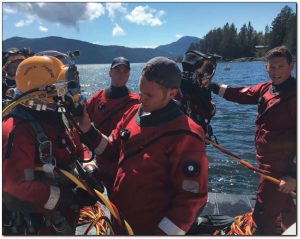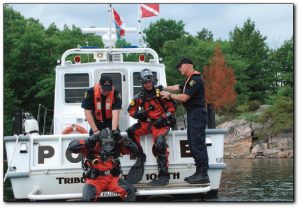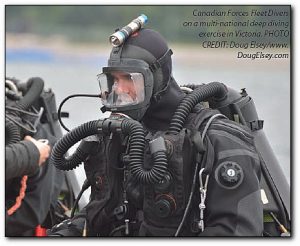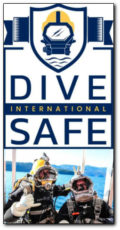Saluting the Military & Public Service: Danger at Any Depth
By CADC Admin ~ July 24th, 2019. Filed under: CADC Mag reprints, EDUCATION, JOBS, Safety, Training, Uncategorized.
 There are many ways to earn a living below the waves. But, for many who are looking to turn their passion for diving into profit, the realities of hardcore commercial diving in the cold, dark, mud of inshore diving—in fast currents or under ice—or doing civil marine repairs, or the prospect of deep bell diving in support of the offshore oil industry, pipelaying, providing drill support or working with submarines or ROVs holds no appeal.
There are many ways to earn a living below the waves. But, for many who are looking to turn their passion for diving into profit, the realities of hardcore commercial diving in the cold, dark, mud of inshore diving—in fast currents or under ice—or doing civil marine repairs, or the prospect of deep bell diving in support of the offshore oil industry, pipelaying, providing drill support or working with submarines or ROVs holds no appeal.
Fortunately, there are still many other career paths that lead throughout the diving industry, including those that serve the greater good within the public safety and service sector.
Opt for the OPP
Stationed north of Toronto at Gravenhurst, the Ontario Provincial Police (OPP) Underwater Search & Recovery Unit (USRU) is one such option. The USRU is responsible for providing safe and effective underwater search capability in the recovery of missing persons, securing evidence of major crimes and incidents, the disposal of explosives, and providing VIP security throughout the Province of Ontario.
To become a member of the USRU, applicants must first be an OPP officer and also possess a valid diving certification from an external agency with a recorded minimum of 25 hours’ bottom time. In addition, applicants must also pass an USRU eight-day selection course and panel interview. If selected for the team, candidates are required to successfully complete a commercial dive course and qualify in restricted SCUBA and restricted surface supplied air.
“We are often asked by civilian, commercial, and recreational divers if they can directly apply to our dive team but, unfortunately, this is not possible,” says Underwater Search and Recovery Unit Sgt. Mike Coo of the OPP.
“Since many of our dives are related to police investigations, our divers need to first have knowledge of how to properly handle evidence, be able to relay information to investigators, and have experience giving evidence in court,” he adds. “Our divers also wear an OPP uniform, including all use-of-force options, and will respond to incidents while travelling to and from dive calls, such as impaired drivers, stolen vehicles, assaults, thefts, and motor vehicle collisions.”
Although rewarding, a career with the USRU is simply not for everyone. The majority of the 100-plus calls the USRU receives each year are directly related to the recovery of drowning victims, which can be physically and emotionally draining for the highly dedicated divers involved.
“We are a close group that relies on each other, not only for physical support during hazardous dive operations but also for emotional support during some of the more difficult recovery operations,” says Coo.
“I often equate it to being able to work day-in and day-out with your buddies,” he continues, “and many members of the dive team will stay well past the requested five-year commitment because of that.”
Cruise the coast with CCG
A career path that may be more accessible to those looking to ply their diving trade could be with the Canadian Coast Guard (CCG), which employs divers as part of its Sea Island base in Richmond, B.C.—one of the busiest search and rescue bases in the country.
Patrolling the mud flats and shallow waters near the Vancouver International Airport, the CCG’s fleet of hovercraft responds to more than 300 calls each year, performing a myriad of tasks that range from search and rescue missions, to supplying medevacs for beachgoers and hikers along B.C.’s inaccessible coastline, to everything in between; if you seek variety in a career, the CCG could be for you.
“While diving is really just a small portion of what we do operationally, it is one activity that demands the most technical training,” says Cameron Knight, diving safety officer at CCG Base Sea Island.
“As such, a lot of our training is entirely focused on the diving aspect of the job—preparing for capsized vessels, downed aircraft, vehicles in the water, and missing divers,” continues Knight. “We are out in the water three or four times a week to ensure we’re ready for when the alarm rings and we’re needed.”
To become a CCG diver, applicants must first obtain some fundamental credentials—basic marine first aid, radio operator certification, some Standards of Training, Certification of Watchkeepers survival craft training, and a basic open water certification such as PADI or NAUI.
Once accepted into the CCG training program, trainees are taken through 16 weeks of Diver Certification Board of Canada induction courses at CCG Station Sea Island base to equip them with the restricted surface supply certification required for their new career. Upon graduation from the program, new CCG recruits will spend their first year being taught the search and rescue trade and receive additional medical EMR-level training, as well as other skills necessary to become well-rounded members of the CCG.
“There is really no prior professional requirement for entrance into the Coast Guard,” says Knight. “Some people come to us who were previously paramedics, electricians, or even worked in the restaurant industry. So long as they come to us with a desire to learn and try something new, we are willing to take them on and train them up. And when you get to see fresh candidates come in off the street and become full-fledged professional rescue divers in the Coast Guard within a year or so, it can be incredibly rewarding.”
Join forces with CF
The Canadian Armed Forces (CF) also provides a diving career opportunity to become a clearance diver. Those wanting to follow this path must already be a member of the CF and must have reached the operational function point in an initial trade, a process that typically takes about four years to complete.
 The chance to attend the year-long clearance diver course occurs annually and involves several rounds of selection aimed at winnowing the applicant pool so only the top candidates remain. If selected, candidates will move on for a week-long clearance diver assessment, ensuring all applicants are in peak physical condition and have a range of personality characteristics desired for clearance divers.
The chance to attend the year-long clearance diver course occurs annually and involves several rounds of selection aimed at winnowing the applicant pool so only the top candidates remain. If selected, candidates will move on for a week-long clearance diver assessment, ensuring all applicants are in peak physical condition and have a range of personality characteristics desired for clearance divers.
“This is essentially a try-out to proceed to the next round of selection,” says Lt(N) Kristopher Hicks with CF’s Fleet Diving Unit Atlantic. “Every candidate will be pushed beyond their pre-conceived personal boundaries and will be tested to their physical, mental, and emotional limits. This is, undoubtedly, the most demanding phase of the selection process and requires a great deal of preparation from each candidate. Completion of the assessment centre is viewed as a significant achievement in its own right.”
Past this phase, a small cadre of candidates are selected to attend the almost year-long clearance diver course in Victoria, B.C., after which they have another six-and-a-half months of explosive ordnance disposal training to undergo at Eglin Air Force Base in western Florida before they are deemed fully qualified as an entry-level clearance diver.
Newly qualified clearance divers are posted to one of the two fleet diving units: Fleet Diving Unit Pacific in Victoria, B.C., or Fleet Diving Unit Atlantic, in Halifax, NS. Early in their careers, clearance divers can expect to participate in a variety of yard diving jobs, including sonar dome maintenance routines, gauging wear-and-tear on propellers, assisting with bringing ships in and out of drydocks for maintenance periods, as well as numerous other tasks.
“The best part of working at a fleet diving unit is being a member of a small, tight-knit community,” says Hicks. “Every clearance diver has had to work extremely hard and overcome numerous challenges to become qualified. As a result, everyone you work with is proud to be there—something that can be a rarity in other sectors.”
(Reprint from CADC Magazine – Spring Summer 2019 – By Paul Adair.)






